🤓 The 2026 Local Search Ranking Factors are here!! Check out the report!
🤓 The 2026 Local Search Ranking Factors are here!! Check out the report!

Day 1 of our first virtual Local Search Summit is complete.🙌 We know it was a jam packed day filled with a ton of information from awesome speakers. If you were too busy watching and forgot to take notes, we’re shining a spotlight on three talks today and sharing all the highlights, insights, and takeaways.
#WLSS Day 1 Talk Showcase:
Want to deepen your knowledge and learn new tactics and strategies to improve your rankings and conversions from local search? Then our Whitespark Local Search Summit video bundle was made for you! For $199USD you will get access to all of the talks from 2021 and 2020.

Google Review Attributes are a feature that allows consumers to leave a “critical” or “positive” quality rating with their reviews in a few short clicks. This is available to almost all service based businesses and is the biggest change to Google reviews in 8 years!
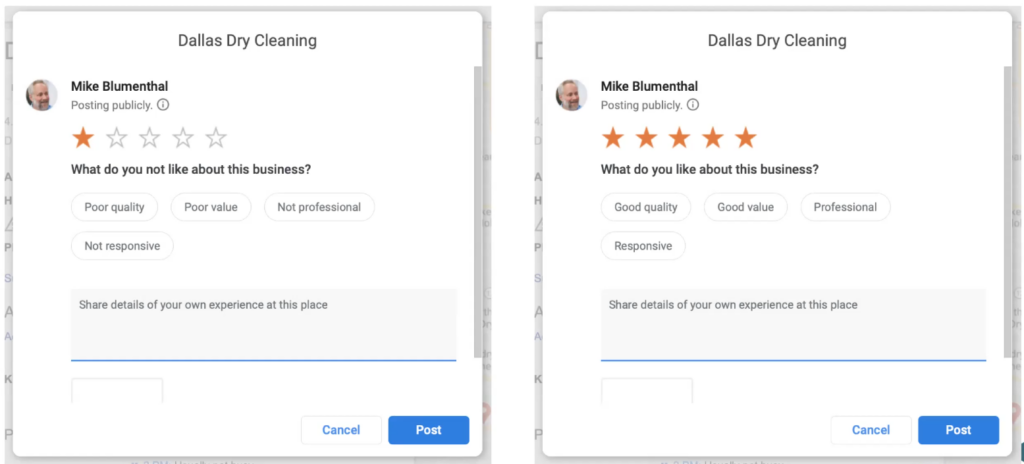
Google review attributes are available in Display and Maps, but once published in a review you can only see them in Search. Do not confuse these with Place Topics, which are machine learning/artificial intelligence assessment of the critical themes in reviews; which often retrieve/generate irrelevant categories.
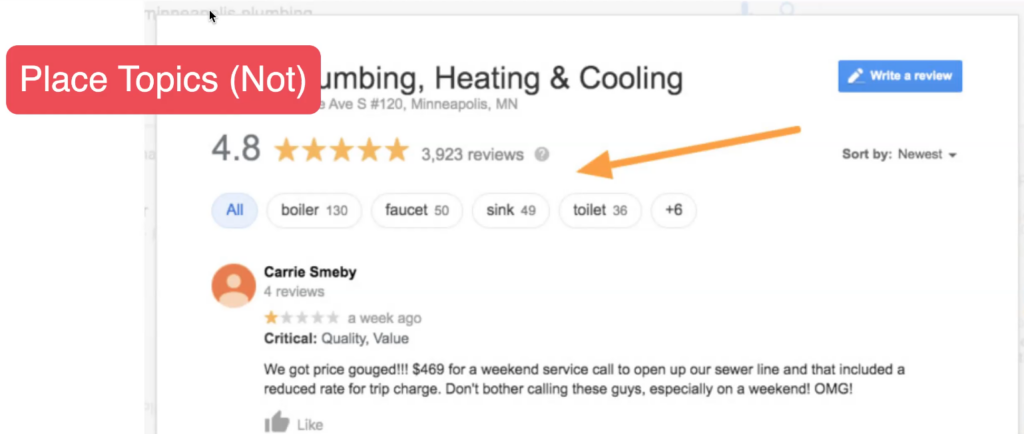
There are variations of attribute choices available by industry and the combinations will always include 1&2 :
If you don’t know which grouping your business has, try to leave a review and see what combination comes up. =Google Review attributes are defined by the Primary Category. These attributes are only showing up for service related businesses. For example, they’re not available to car dealers and jewelry stores, but showing up for the custom jeweler and lawyer categories.
Google review attributes are visible in over 275 categories, however Mike believes it trends toward 500 of Google’s 4,000 categories (hot damn that’s a lot of categories).
Why are they so important?
Reviews have been one of two types since the days of CitySearch and before.
But there was no way to standardize the review content.
GatherUp looked at 2,778,965 reviews and found that 34.5% were rating only reviews. From the searching consumer’s point of view, a rating doesn’t tell them much, a customer was happy or unhappy but they don’t know why. Ratings alone also don’t tell the business much, what did they do wrong? And they doesn’t tell Google much, what is the problem in this situation?
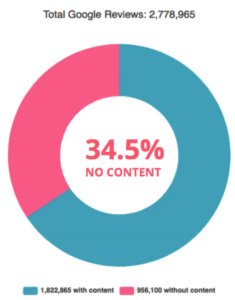
Problem: In search results, Google compresses the ratings and you will often see that many businesses have largely the same number of reviews and same rating. This creates a problem from a consumer, business, and rankings point of view. 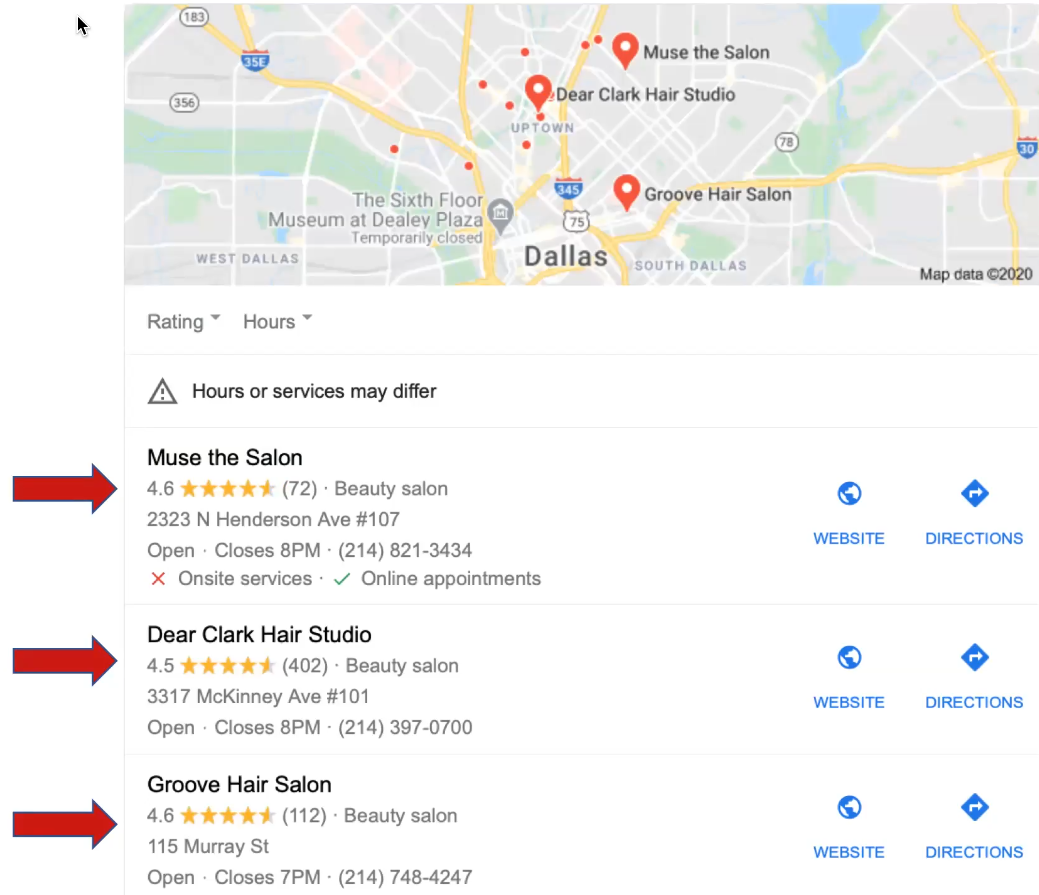 Solution: Review attributes
Solution: Review attributes
Attribute Values Relating to a Rating on a Points ScaleThis essentially gives Google the ability to solve the bunching problem in search results, in terms of whatever value they give to ratings. It also gives Google a quantitative difference to understanding one business, versus just a qualitative difference. Google Attributes are Semantic Triples
A Semantic Triple – Is a format of data that enables the machine to represent knowledge in a way that they can read it and understand it. It can be unambiguously queried and reasoned about.
 Google loves this stuff! It helps them dramatically increase entity understanding – they not only know where the business is located, what the ratings are, what the reviews are, they now have sophisticated data providing understanding about the business.
Google loves this stuff! It helps them dramatically increase entity understanding – they not only know where the business is located, what the ratings are, what the reviews are, they now have sophisticated data providing understanding about the business.
How Do You Track Google Review Attributes?
Right now you cannot see these in your GMB dashboard, they are only visible in search results. But, if you use GatherUp or our Reputation Builder, the tool will track your Google review attributes for you.
Why Monitor Google Review Attributes?
Attribute Opportunities
Monitoring your Review Attributes helps for your business be accountable and really show up in your service work. If you want to be seen as the company that is always on-time, how can you follow through with that if you aren’t getting those attributes?
Many businesses look at reviews as a one and done tactic, but reviews are rich resources you need to be utilizing. Why leave a review on the shelf? Share it on your website, share on social, and take the time to analyze it. Don’t have a siloed view when it comes to reviews.

Gyi is well known in local search circles for his catch-phrase “meh, links” which is the most succinct way of saying,
“All other SEO factors considered, it’s probably the links that are making the difference in why one business is outranking another”
You will hear a lot from people within the industry that “links are way oversold, all you’ve got to do is create great content, fix your site, incorporate searcher intent, create for users, add Schema…” Yes, all of that is important… BUT the difference maker is the links. Re-frame your mindset around local link building, especially in competitive verticals.
It’s time to correct your myopic view on link building and stop thinking about everything you’ve ever learned. So many people are too nearsighted with their link building, too focused on that direct connection with trying to rank. Open your mind to new concepts in local link building. Go beyond the context of rankings and start thinking about it in terms of a business development strategy. Disclaimer: Do your own tests! Trust your own data. What works for one client in one industry may not work for another. Put your own systems in place for tracking and put a premium on your own data. What metrics should we focus on for local link building?
Don’t focus on overall link numbers, but rather increasing the number of linking root domains. Yes, your industry can be competitive, but by targeting and going really deep on relevance (both topical and geographical) you can outrank some pages that have more linking root domains.
For local link prospecting you can pretty much ignore Domain Authority (DA) and focus on relevance instead by identifying relevant prospects, both topically and geographically.
What about nofollow links? For local link prospecting, don’t exclude nofollow. A lot of link builders won’t put a site on their prospecting list because they know they don’t provide follow links. HUGE MISTAKE.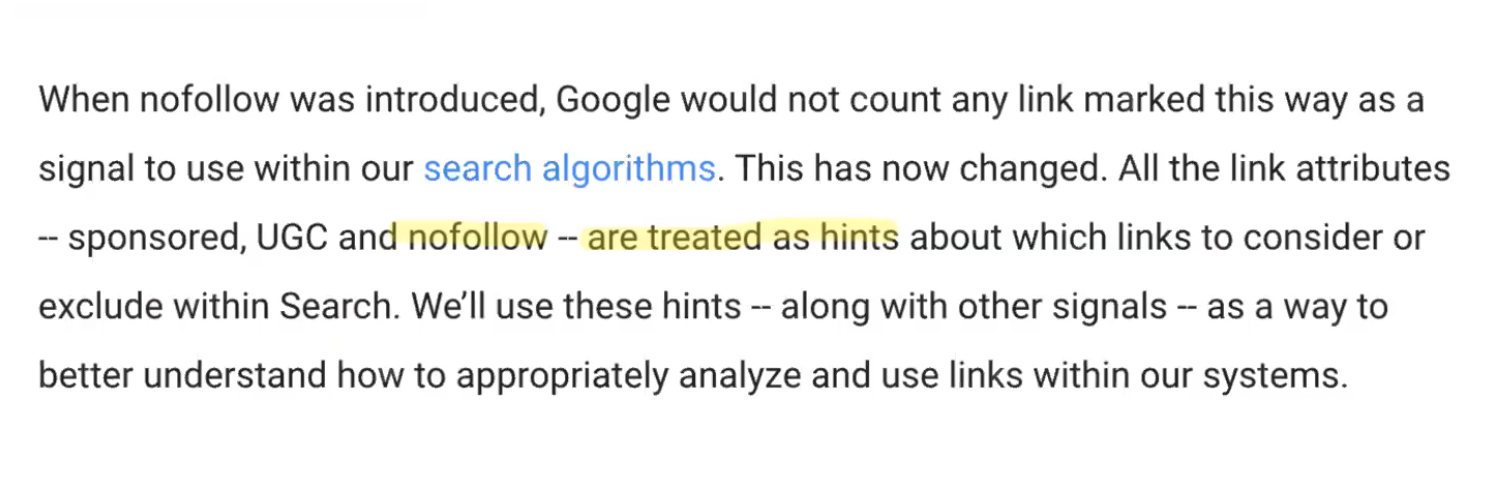 If you acquire local links, even with no-follows, they do have an impact overall and they do something else: generate customers and leads.
If you acquire local links, even with no-follows, they do have an impact overall and they do something else: generate customers and leads.
Anchor Text – For local link prospecting, don’t obsess over anchor text. Where you can get it, great, but don’t stress about it overall. Brand and “junk” anchors are fine. Don’t remove a prospect from your list just because you can’t optimize anchor text.
Scale – For local link prospecting, you can’t scale and you don’t need to scale. Think hyper-local, geographic and topical relevance.You don’t need to be getting thousands of links in the local context in order to beat competitors. 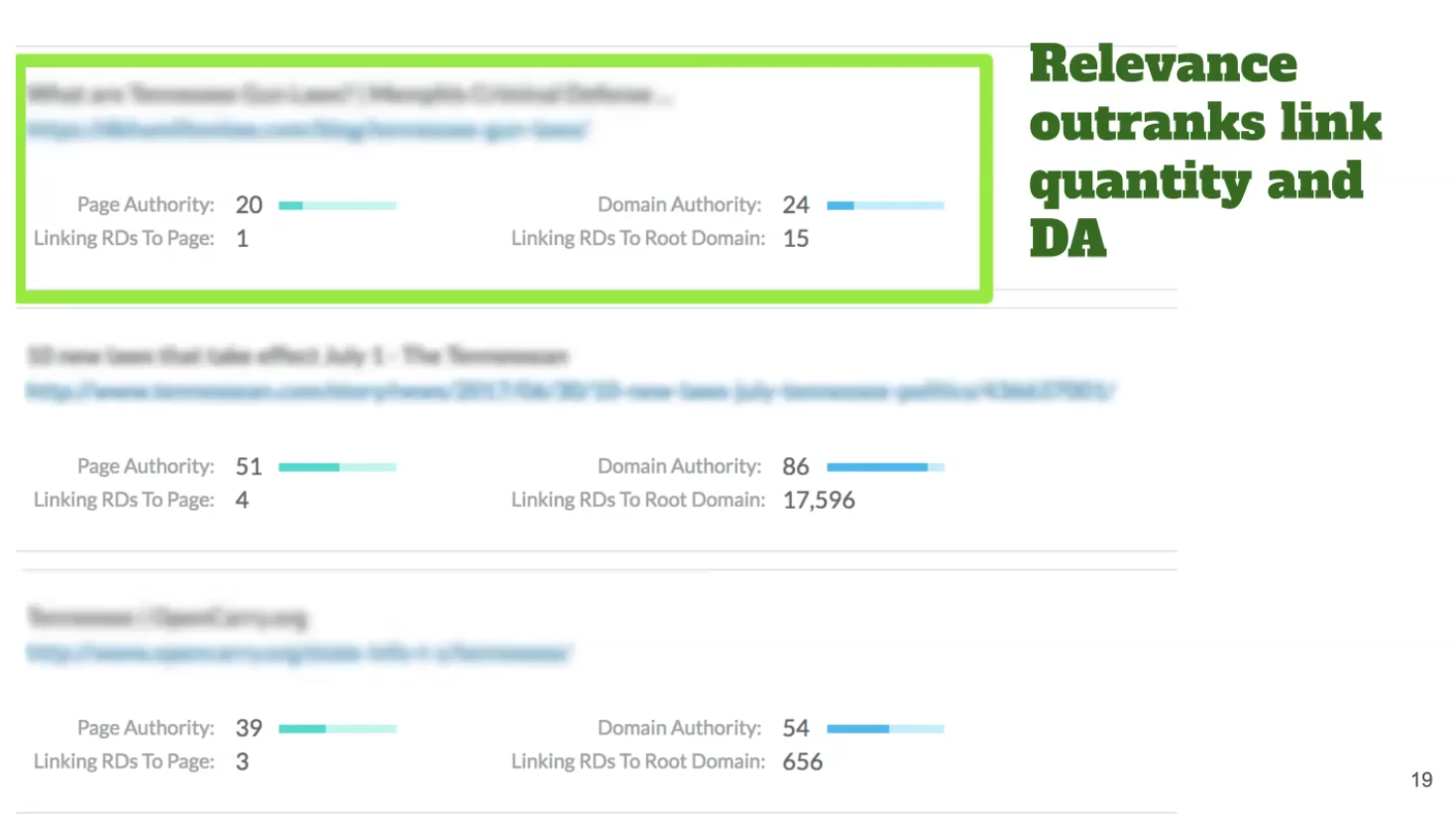 Must Link – For local link prospecting, don’t ignore linkless citations. If you can get the link get it, but don’t dismiss sites simply because they have a no link policy.
Must Link – For local link prospecting, don’t ignore linkless citations. If you can get the link get it, but don’t dismiss sites simply because they have a no link policy.
$$$ > Traffic > Rankings – Your links can generate revenue, customers, leads, sales, and traffic. Money and traffic beat rankings every time.
Target Audience Local Link Building
Build out your target audience persona, prospect link targets like you would buy media. This will help you build out a list of sites where your customers will actually go. 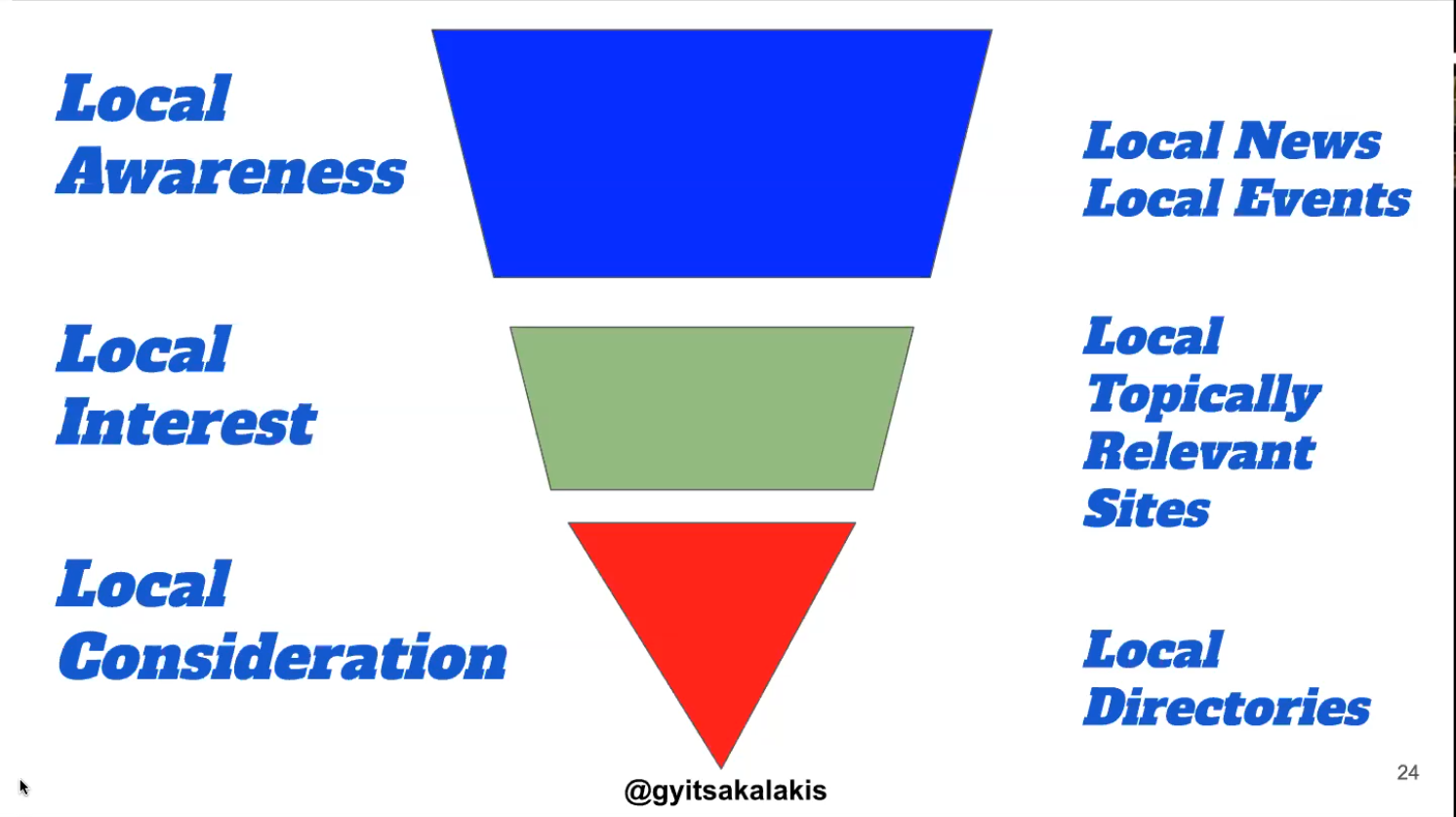 Think about this in the context of local awareness, interest, and consideration. Local news and events are the money makers. Start building relationships with journalists, go in and comment where you can, get active in your community. Whether you’re speaking, participating, or sponsoring a local event, link these topically-relevant local events. They can really move the dial from a link building standpoint.
Think about this in the context of local awareness, interest, and consideration. Local news and events are the money makers. Start building relationships with journalists, go in and comment where you can, get active in your community. Whether you’re speaking, participating, or sponsoring a local event, link these topically-relevant local events. They can really move the dial from a link building standpoint.
Local Directories (both industry and geographic specific) – Make sure your information is accurate.
Who: Demographics + Psychographics
Where you can find patterns in terms of age, socioeconomics, etc. – what keeps those people up at night – think about this, as it will tell you where these audiences spend their time online and what sites they are looking at.
What Are They Searching Locally?
Go super hyper-local: neighbourhood, specific areas, and streets. If you’re focused on super hyper-local areas, that’s where you’ll see bang for your buck within the radius of the search area for your business location.
What Ranks Locally?
The best indicator of whether Google thinks something is relevant or popular is if Google ranks it themselves. Find the different sites that rank locally and put them on your prospect list. The most relevant type of link you could get would be from a competitor that does the exact same thing as your business. Obviously they aren’t going to want to link to you. But think about tangential businesses, what about other businesses that don’t compete with you?
Dive deeper into the results, go beyond the first page and you will start to find options.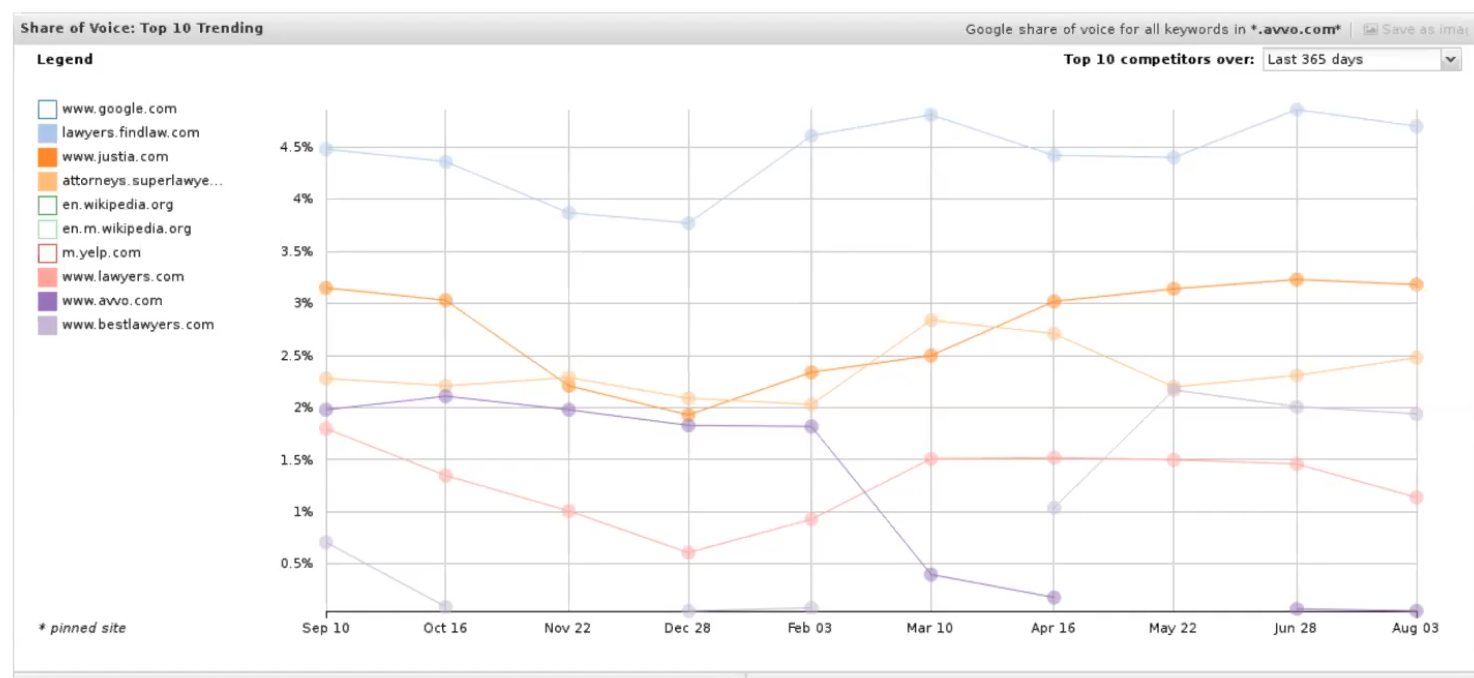 Best Local Link Building Tool: Google
Best Local Link Building Tool: Google
Use advanced search operators such as inurl and intitle to prospect for links. For example:
[something your target audience might also search for] + inttitle:[hyper-local geo-modifier]
For the hyper-local modifier, you want to go deep like the neighbourhood or street.
Second Best Local Link Building Tool: Maps
Put your own business address in and start to look at all the different businesses around your physical location. The proximity of getting local links from businesses that are in your own area makes a big difference. Ideally they are also topically relevant. For example, a Personal Injury Lawyer can get links from rehabilitation businesses or ancillary services clients might be using locally.
Leverage Google Maps by using your own address, zooming in and looking around. Think about:
Hyper-Local Content Marketing For Links
==When you focus only on Domain Authority for your local link building campaigns, you’re going to end up missing out on opportunities that are both topically and locally relevant, which are both way more important and stronger signals/factors when it comes to earning links as a local business. Pro Prospecting Tip: Doing your prospecting through Google – Gyi loves to use the MozBar (a Chrome/FireFox extension) that allows you to export all the Search Results into a CSV. If you tack on a little parameter &num=100 to the URL after you run the search, you can get all 100 search results exported in a spreadsheet and work through that, rather than drilling through the results. Local link building is a grind – embrace the suck!
Re-framing is critical and will help you during all your link building campaigns. If you hold yourself accountable for topical and local relevance, the list isn’t as long as you think. It’s not about going out and trying to get 100s of linking root domains, it’s about trying to get like 25 solid ones. Spend the time getting to know the business or site you’re trying to go after. From an email outreach standpoint, if you’re cold emailing you’re not going to get a lot of traction, take the time to develop rapport with the business to get more positive and engaged responses to your outreach.
In local you don’t need the volume, you need to be relationship-focused and locally-focused. ==
Deepen your knowledge and learn new tactics and strategies to improve your rankings and conversions from local search. Get our special video bundle that gives you full access to all sessions from our 2020 & 2021 Local Search Summit events!

Why add UTMs?
As a marketer, you need to demonstrate the excellent value of your work to an organization, as well as demonstrate the value GMB can add.
Mobile browsers and apps typically don’t send referral info to Google analytics and often the traffic gets misplaced in the direct traffic bucket. When there is no UTM in place, organic and direct clicks gets muddled and this information doesn’t get sent to analytics. Also, GMB insights are lacking: they don’t tell us the true number of people who click through.
What can I tag in GMB?
=The ROI on 5 mins work:
Here’s an example of creating a new follower offer. It sits there quietly driving traffic and interested parties to the website, but interestingly is also driving sales! While it’s only generating a very small number of sessions, it took us five minutes to create and has an e-commerce conversion rate of 21.43%.
Adding the new follower offer is a bit of a no-brainer if you’ve got the type of business that is going to attract a local following on Google Maps. Anyone that follows you will have your Google Posts pushed directly into the For You tab under Updates in the Google Maps app. That new follower could be the gift that keeps on giving in terms of revenue. You have to download the GMB app for your business to access the Welcome/New Follow Post type… But it may be worth it for your business! 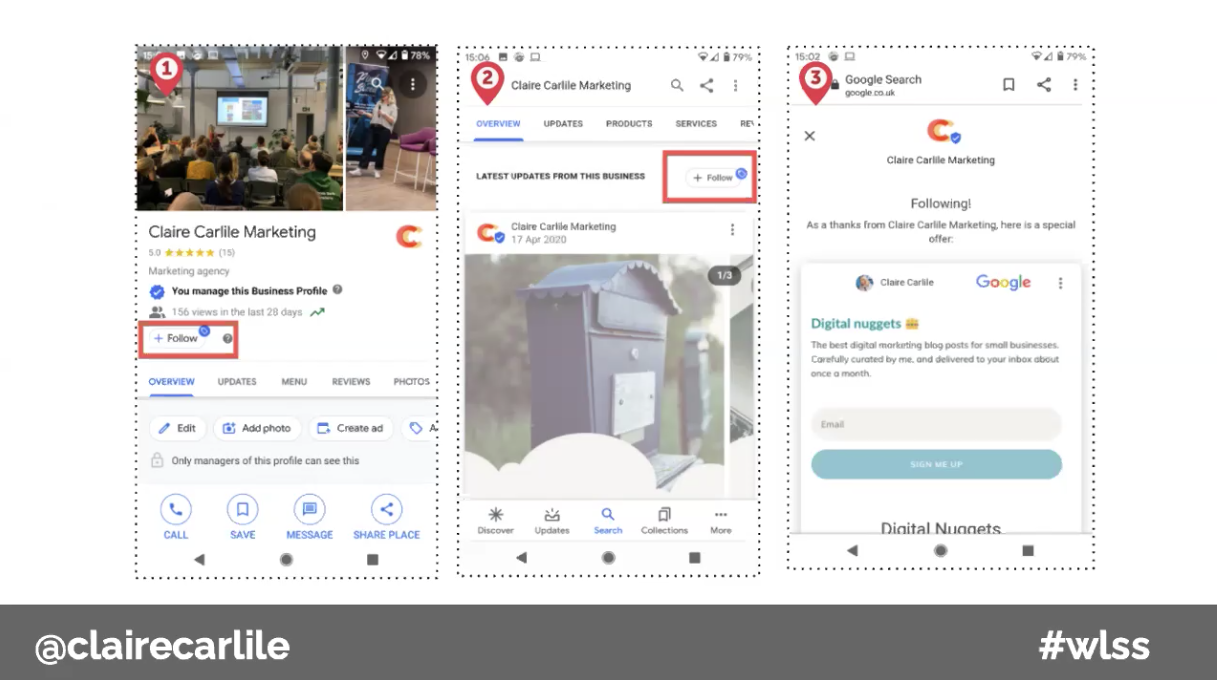 UTM Tagging Tips
UTM Tagging Tips
UTM Tagging Example
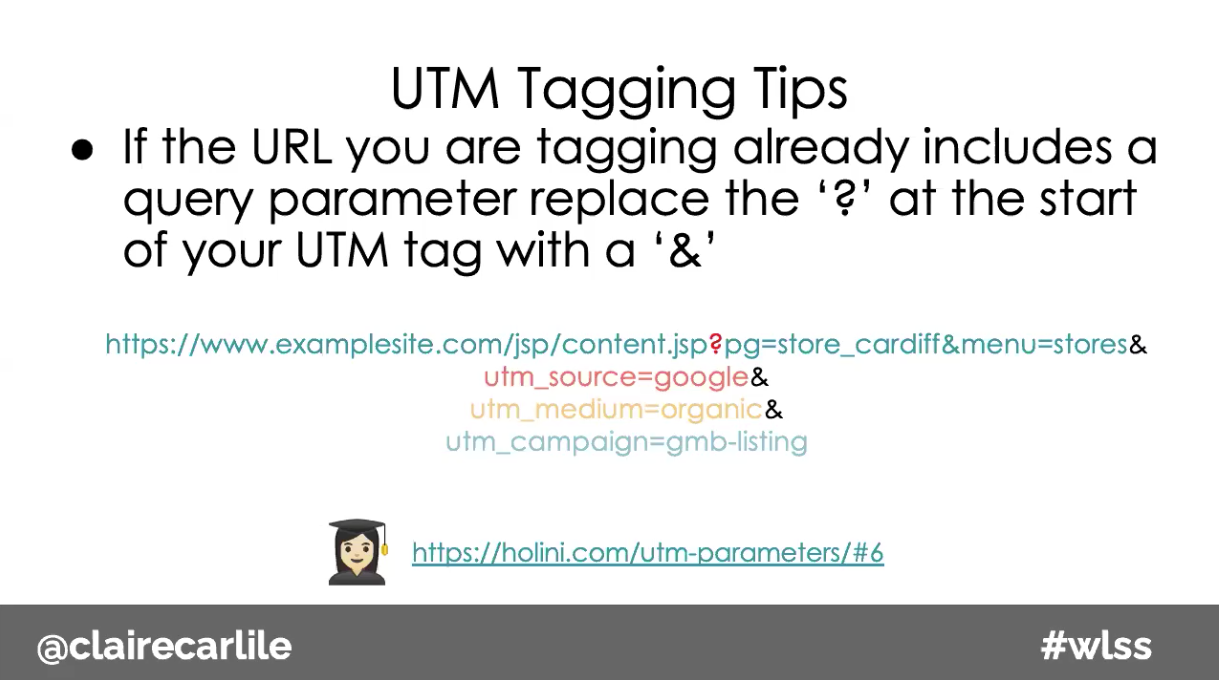 UTM Source vs Medium: Think of a click through of a UTM tag as a journey. The source would be where the journey started and the medium would be the method of transport.Using UTM tags will show us the actual monetary value the GMB clicks are driving. But it’s not always about revenue – micro-conversions for the win!
UTM Source vs Medium: Think of a click through of a UTM tag as a journey. The source would be where the journey started and the medium would be the method of transport.Using UTM tags will show us the actual monetary value the GMB clicks are driving. But it’s not always about revenue – micro-conversions for the win!
What conversions and micro-conversions is GMB driving on your website?
And anything else that’s important to your business or organization. All you need to do here is make sure that your goals in Google Analytics are mapped out against your key performance indicators (KPIs) so that you’re measuring what’s actually important to your organization.
GMB is assisting in conversions.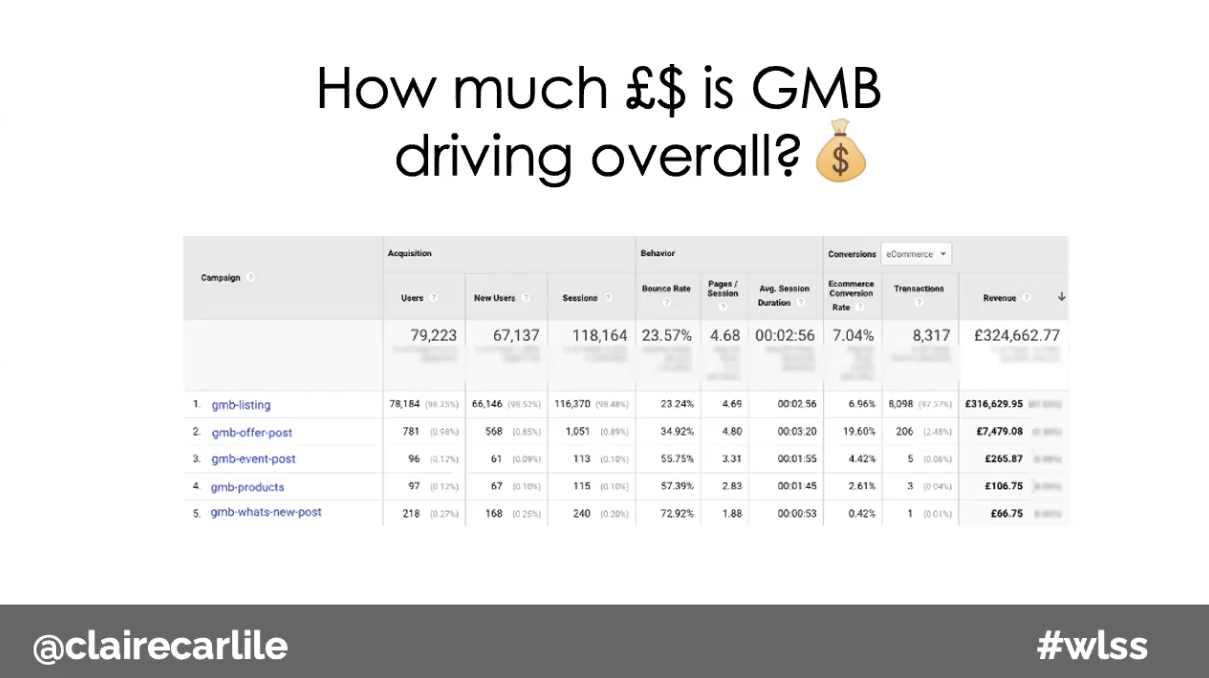 Assisted conversions attributed to £95,000 within a look-back time frame of 30 days prior to the conversion. In the 30 days prior to the conversion, the GMB website link contributed to the conversion journey of 7,483 conversions. It’s important to consider the Google My Business links and you need to think about their role in exposing your potential customers to your brand in the early stages of the customer journey, as well as the GMB role in supporting and driving consideration in the middle of the funnel.
Assisted conversions attributed to £95,000 within a look-back time frame of 30 days prior to the conversion. In the 30 days prior to the conversion, the GMB website link contributed to the conversion journey of 7,483 conversions. It’s important to consider the Google My Business links and you need to think about their role in exposing your potential customers to your brand in the early stages of the customer journey, as well as the GMB role in supporting and driving consideration in the middle of the funnel.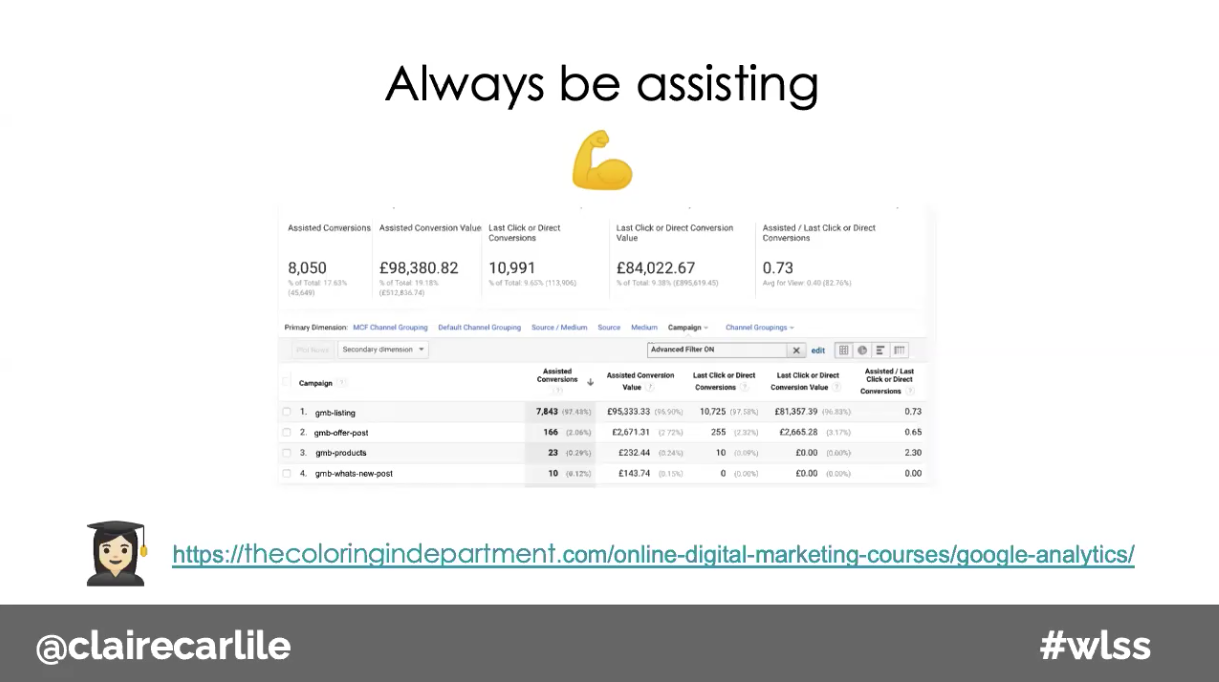 Search Query Data & Performance in Google Search Console
Search Query Data & Performance in Google Search Console
Make the most of this data while it’s still there in Search Console (GSC). Log in to GSC, go to the Performance Report, you can add a page (…) filter that will act as a catch-all for all your GMB tagged URLs.
You’re essentially asking Google to include URLs containing UTM campaign = GMB. Once the filter has been applied, GSC will give the data on clicks, impressions, average click-through rate, and average position for the URLs that contain GMB. Now you’ve got all of this lovely data that can be used for our search query research and to help you understand your existing organic visibility and how and where you can improve.

